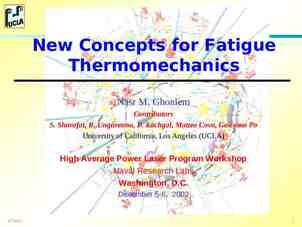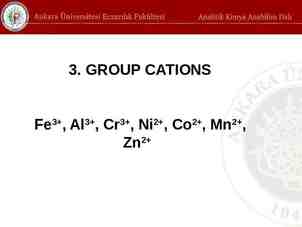Caught-In Hazards Bureau of Workers’ Compensation PA Training
42 Slides2.29 MB
Caught-In Hazards Bureau of Workers’ Compensation PA Training for Health & Safety (PATHS) PPT-126-01 1
Main Topics A. Hazard Recognition 1. Cranes and Heavy Equipment 2. Tools and Equipment 3. Materials Handling 4. Trenches and Excavations B Accident Prevention 1. Guarding Moving Equipment/Parts 2. Barricades 3. Proper Materials Handling 4. Shielding/Trench Boxes PPT-126-01 2
Caught-In Injuries Caught-in injuries are the result of a worker being crushed between objects, rather than being injured from the impact of an object. PPT-126-01 3
Caught-In Hazards Common types of Caught-In or Between Hazards: Machinery that has unguarded moving parts Buried in or by Pinned between PPT-126-01 4
Caught-In Hazards Categorized As: Cave-ins Being pulled into or caught in machinery and equipment Being compressed or crushed between rolling, sliding or shifting objects. PPT-126-01 5
Caught-In Hazards Caught-in hazards are one of the four most deadly hazards found at construction sites. Safe This program will help you recognize common caughtin hazards. The symbol will tell you if the situation in the picture is either safe or not safe. PPT-126-01 Not safe 6
Caught-In Statistics Each year, workers die from ‘caught-in’ accidents. On Average: Total deaths from ‘caught-in’ cases: 388 Caught-in deaths in construction: 95 Approximately 8% of deaths in construction are from ‘caught-in’ accidents. Approximately 7% of all occupational deaths are from ‘caught-in’ accidents. PPT-126-01 7
Hazard Recognition Caught-in hazards occur when a worker is caught inside of or in between different objects. PPT-126-01 8
Cranes & Heavy Equipment Caught-in hazards are often created when working around heavy equipment. PPT-126-01 9
Cranes & Heavy Equipment Never place yourself between a piece of heavy equipment and an immovable object. PPT-126-01 10
Cranes & Heavy Equipment Never work in the swing radius of rotating equipment. PPT-126-01 11
Cranes & Heavy Equipment Always work at a safe distance from equipment. PPT-126-01 12
Tools and Equipment Caught-in hazards exist when workers remove or disable guards on tools or equipment. PPT-126-01 13
Tools and Equipment Never place your hands or body near moving parts. PPT-126-01 14
Tools and Equipment Gloves, long sleeve shirts, jewelry, or loose fitting clothing can be hazardous if caught in moving parts. PPT-126-01 15
Tools and Equipment Never use equipment that is missing guards or other protective devices. PPT-126-01 16
Material Handling Use caution when handling materials PPT-126-01 17
Material Handling Be careful when stacking and storing materials. PPT-126-01 18
Material Handling Do not place yourself between materials and an immovable structure. PPT-126-01 19
Trenches & Excavations Workers inside of an excavation must be protected from a cave-in PPT-126-01 20
Trenches & Excavations Workers are exposed to a potential cave-in when there are unprotected sides PPT-126-01 21
Trenches & Excavations Workers could be caught-in between the sides of an excavation and pipes or other objects inside the excavation PPT-126-01 22
Trenches & Excavations Never work inside an excavation where water is accumulating. PPT-126-01 23
Accident Prevention A willing, positive attitude towards safety will help make a safer work environment. PPT-126-01 24
Accident Prevention Plan your work and look for potential hazards. Each task will have different hazards. PPT-126-01 25
Guarding Moving Parts Always use equipment with all of the guards properly adjusted and in position. PPT-126-01 26
Guarding Moving Parts Always use equipment with rotating or moving parts that are properly guarded. PPT-126-01 27
Guarding Moving Parts Always use tools or equipment that is properly guarded. PPT-126-01 28
Guarding Moving Parts Some equipment may need to be guarded by distance. PPT-126-01 29
Barricades When working near equipment, such as cranes, use a barricade to identify the unsafe area. PPT-126-01 30
Barricades Barricades must be maintained PPT-126-01 31
Proper Material Handling Properly handle and guide materials that are being flown overhead. PPT-126-01 32
Proper Material Handling Be safe when moving materials. PPT-126-01 33
Protective Systems Before performing any excavation work, all employees must be trained. When excavation work is taking place, a competent person must be present. Anytime an excavation’s depth is greater than 5 feet and less than 20 feet, a competent person must select the protective system to put in place. Excavations over 20 feet require the design of a protective system by a licensed professional engineer. PPT-126-01 34
Shielding/Trench Boxes Benching and sloping prevents the sides of a trench from collapsing onto workers inside the trench. Anytime an excavation is greater than 5 feet in depth, protective systems must be in place. PPT-126-01 35
Shielding/Trench Boxes A safe way to enter and exit excavations must be provided any time there is a trench. PPT-126-01 36
Shielding/Trench Boxes Regardless of the type of protection used, a safe way to enter the trench is required. PPT-126-01 37
Caught-In Prevention Protecting against Caught-In or –between hazards: Use machinery that is properly guarded Use other methods to ensure that machinery is sufficiently supported, secured or otherwise made safe. Protect yourself from being pinned between equipment, materials or other objects. Protect yourself on excavation sites Conduct training PPT-126-01 38
Questions PPT-126-01 39
Contact Information Health & Safety Training Specialists 1171 South Cameron Street, Room 324 Harrisburg, PA 17104-2501 (717) 772-1635 [email protected] Like us on Facebook! https://www.facebook.com/BWCPATHS PPT-126-01 40
Working Team for this Presentation UNIVERSITY OF PUERTO RICO MEDICAL SCIENCES CAMPUS Graduate School of Public Health, Dep. of Environmental Health Sergio Caporali, Ph.D., CSP – Principal Investigator Lida Orta-Anés, Ph.D., Field Trainer Marcilyn Colón Colón, MSc., Training Coordinator Harlyn Rivera, Administrative Assistant PPT-126-01 41
Working Team for this Presentation CONTRACTORS Circe E. Niezen, ME, MBA, Training Evaluator, PUPR Mark Fullen, Ph.D. Candidate, Field Trainer and Curriculum Developer, WVU Carmen Vázquez, RN, Field Trainer Migdalia Ruiz, MS, Field Trainer Carlos Ortiz, Ph.D., Online Training Administrator, UPR-CPRS-OIRE Eliel Melón Ramos – Online Training Adm. Assistant, UPR-CPRS-OIRE PPT-126-01 42















































